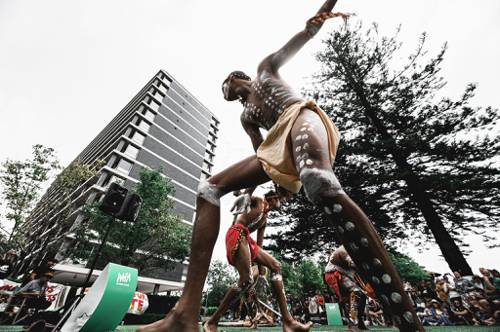
FAQ About The Cultural Significance of Dance in Indigenous Communities

What role does dance play in indigenous communities?
Dance in indigenous communities often serves as a powerful expression of cultural identity and a means of preserving heritage. It is used to convey stories, celebrate significant events, and maintain a connection with ancestral traditions and spiritual beliefs. By participating in traditional dance, community members reinforce social bonds and pass down cultural values and narratives from one generation to the next.

How does dance help in preserving indigenous heritage?
Dance helps in preserving indigenous heritage by maintaining historical and cultural traditions that might otherwise be lost. Through the careful teaching and practice of traditional dances, communities can keep alive the languages, stories, and customs that define their identity. Dance also serves as a living record of societal values, historical events, and religious practices, ensuring they remain relevant and accessible to future generations.

Are there specific dances linked to indigenous ceremonies?
Yes, many indigenous dances are specifically linked to ceremonies and rituals. For instance, in Native American cultures, the Sun Dance is a spiritual ceremony that includes specific dance rituals. In the Maori culture of New Zealand, the haka is a traditional war dance with ceremonial importance. These dances are integral to their respective ceremonies, often performed to honor spiritual entities, commemorate ancestors, or mark significant life events such as births, weddings, and deaths.

Why is dance important for social cohesion in indigenous communities?
Dance plays a crucial role in social cohesion in indigenous communities by fostering a sense of unity and belonging. Participating in communal dances reinforces group identity and allows members to express and share their cultural values. Dance gatherings provide opportunities for social interaction, helping to strengthen relationships and resolve conflicts within the community. This shared cultural practice helps maintain harmony and solidarity among members.

How do indigenous dances vary across different cultures?
Indigenous dances vary widely across different cultures, often reflecting the unique landscapes, histories, and traditions of each group. For example, the traditional dances of the Aboriginal peoples of Australia often emulate animals and natural phenomena, while the Inuit of the Arctic regions incorporate storytelling in their movements. Differences in music, costumes, and accompanying ceremonial elements also distinguish these dances, showcasing a rich tapestry of cultural diversity.

Can indigenous dances be used for educational purposes?
Yes, indigenous dances serve significant educational purposes. They are tools for teaching younger generations about their history, values, and social norms. Through dance, children learn not only the movements but also the stories, myths, and meanings behind them. This educational role helps ensure cultural continuity and provides a comprehensive method for preserving languages and oral traditions.

What are the common features of indigenous dance across cultures?
Common features of indigenous dance across cultures often include symbolic movements that convey cultural stories, communal participation, accompaniment by traditional music or instruments, and the use of traditional costumes or body paint. These elements contribute to the dance's role in maintaining cultural identity and function as expressions of spirituality, social structure, and ecological awareness.

How are indigenous dances transmitted through generations?
Indigenous dances are typically transmitted through generations orally and through direct teaching. Elders and community leaders often lead dance instruction, using demonstration and storytelling to convey the significance of each movement and the context of the dance. This personal and immersive teaching method ensures the preservation of the dance's cultural and spiritual meanings.

What challenges do indigenous communities face in preserving their dance traditions?
Indigenous communities face several challenges in preserving their dance traditions, including globalization, cultural assimilation, and loss of language. External influences can lead to the erosion of traditional practices, while migration and urbanization may reduce opportunities for communal gatherings and dance practice. Furthermore, the passing of elders without documenting their knowledge can jeopardize the continuity of these traditions.

How do indigenous dances express cultural identity?
Indigenous dances express cultural identity by reflecting the unique traditions, values, and histories of a community. Through specific movements, costumes, and music, these dances convey the distinct narratives and worldviews of the people, reinforcing a sense of pride and belonging. Dance acts as a visible and dynamic affirmation of cultural identity, making it an integral element of cultural continuity and expression.

Are there any modern adaptations of traditional indigenous dances?
Yes, many indigenous communities are adapting their traditional dances in contemporary contexts to reflect changing social and cultural landscapes. These adaptations may involve incorporating contemporary music, themes, or technology such as multimedia elements while maintaining the dance's core cultural significance. Such innovations allow these arts to remain relevant and accessible to younger generations and broader audiences.

What role does music play in indigenous dance?
Music plays a central role in indigenous dance, often guiding the rhythm and mood of the performance. Traditional instruments, such as drums, flutes, or rattles, accompany the dance, enhancing its spiritual and cultural impact. Songs and chants infuse the dance with layers of meaning, contributing to its storytelling and ceremonial purposes. The interplay between music and movement is vital in heightening the expressive power of the dance.

How does dance in indigenous communities differ from Western dance forms?
Dance in indigenous communities often differs from Western dance forms in purpose, structure, and expression. Indigenous dances are usually communal and tied to cultural, spiritual, and historical contexts, whereas Western forms may focus more on entertainment and individual expression. Additionally, indigenous dances often integrate storytelling, symbolic movements, and traditional cultural practices, which are sometimes less prominent in Western dance genres.

What is the significance of costumes in indigenous dances?
Costumes in indigenous dances carry significant cultural meanings and often symbolize specific stories, deities, or historical events. Elaborate and colorful attire or body paint may enhance the visual storytelling and express the cultural identity of the performers. These costumes are usually crafted using traditional materials and methods, adding authenticity and historical continuity to the dance.

How does indigenous dance connect to spirituality?
Indigenous dance often has deep spiritual significance, serving as a form of communication with deities, honoring ancestors, or performing rites of passage. The movements, music, and ceremonial context are imbued with symbolic meaning, aligning the dancers with spiritual realms and facilitating rituals of healing, fertility, or protection. Dance becomes a medium through which spiritual beliefs and practices are enacted and lived.

Do indigenous dance practices have health benefits?
Yes, indigenous dance practices can offer numerous health benefits. Physically, they promote fitness, coordination, and stamina, making them an excellent form of exercise. Mentally and emotionally, dance can enhance well-being by reducing stress, enhancing mood, and fostering community connections. The cultural engagement and sense of identity that accompany these dances also contribute to the overall mental health of participants.

How has globalization impacted indigenous dance traditions?
Globalization has had both positive and negative impacts on indigenous dance traditions. On one hand, it has facilitated the global spread and recognition of these unique cultural expressions, providing platforms for sharing and celebration. On the other hand, globalization poses a threat through cultural homogenization and competition with dominant entertainment forms, which can overshadow and dilute traditional dance practices.

Why is it important to support indigenous dance festivals and events?
Supporting indigenous dance festivals and events is crucial for the preservation and promotion of cultural heritage. These gatherings provide communities with opportunities to showcase their traditions, educate the public, and foster intergenerational and cross-cultural dialogue. By attending and supporting these events, audiences can help sustain the cultural vitality and visibility of indigenous dance.

Can indigenous dances promote intercultural understanding?
Yes, indigenous dances can promote intercultural understanding by providing insights into the values, beliefs, and histories of different cultures. By sharing these dances with broader audiences, communities can bridge cultural divides, fostering respect and appreciation for diversity. Such exchanges encourage dialogue and learning, contributing to mutual respect and global cultural harmony.

How do indigenous children learn about their cultural identity through dance?
Indigenous children learn about their cultural identity through dance by participating in traditional practices that transmit their community's values, stories, and histories. Dance serves as an educational tool, where children engage with the meanings behind the movements, music, and costumes. This hands-on learning experience strengthens their connection to their heritage and reinforces their sense of belonging and identity.
